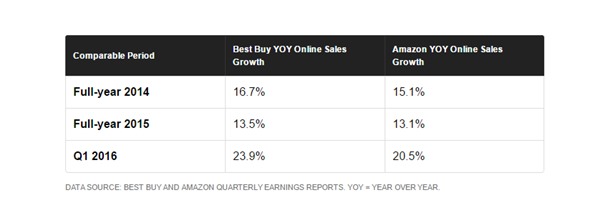The Heroic Rise Of Best Buy’s Omnichannel Customer-Centricity Model
The journey that Best Buy
has traveled towards success has indeed been a heroic one – and I do mean ‘heroic’ in the literary sense of the word.The electronics retailer has fought its way through an obstacle-laden, enemy-guarded pathway to prosperity, which, as anyone in corporate business will tell you, is comparable to any hero’s journey – from Prometheus to Batman to LeBron James – in no uncertain terms.
Indeed, many challenges have been thrown down along Best Buy’s voyage, rivals have attempted to out maneuver the retailer so they may win the day themselves, allies have been formed along the way, as indeed have new enemies. But, time and time again, the electronics chain has dug deep, drawn on its wits, its steely resolve and its covetable customer-centric skillsets to ensure that it pulled through. Indeed, these are all inevitable occurrences of a successful retailer’s heroic journey, and, thankfully for Best Buy, in the end have manifest in what is perhaps the most important survival trait of all triumphant heroes – the ability to grow (and if Universal Pictures haven’t already bought the movie rights, then I’m tempted to place a bid myself!).
The Birth Of Omnichannel
It’s no secret that at the turn of the millennium, at a time when ecommerce first began its rapid growth, Best Buy stores were struggling as consumer preference for buying electronic goods online started to increase. As is the case with all great heroic journeys, the odds at this point in time seemed stacked against Best Buy’s success.
However, digging deep, the company turned to what was then a revolutionary customer-centric approach, and began fighting back.
Today, Best Buy is the largest multi-channel consumer electronics retailer in the world – but long before such a thing we now call ‘omnichannel’ was an industry buzzword, Best Buy had already started to focus on a strategy that would revamp its customer experience across all the channels its customers use.
In ‘The History of Omnichannel
’ – a blog series for RSR Research – author Nikki Baird goes so far as to bestow on Best Buy the accolade of being the company that gave birth to omnichannel initiatives.
“Omnichannel starts way back in 2003,” Baird writes. “And one of the reasons why it’s important to go back that far is because I think a lot of people forget or lose sight of the fact that omnichannel didn’t begin as omnichannel, or even cross-channel. It began as Customer Centricity. And the retailer who should get credit for putting Customer Centricity on the map is Best Buy.”
Baird explains that at the time Best Buy was struggling – unable, as it was, through a lack of resources, to beat out its competitors like Walmart through lower prices. And so the retailer decided that it would focus its efforts elsewhere –namely, on providing its customers with a better experience. In hindsight, it’s truly remarkable to consider just how ahead of its time Best Buy was, as now, in 2016, the customer experience is in fact the most important way that retailers attempt to differentiate.
The new strategy was, however, a turning point on Best Buy’s journey. As Baird explains, the tactic focused on helping customers “build their own path to purchase by assembling from the various product and service offerings that Best Buy offered. And they viewed that path to purchase as everything from researching products to post-sales service and support.”
The Growth Continues
The assumption for Best Buy back in 2003 was that customers would be willing to pay a little more for a better service. And it’s one that paid off – but that’s not the end of our hero’s story.
In 2012, more revolutionary moves were on the cards. Hubert Joley – the man who was previously responsible for growing Carlson Wagonlit Travel sales from $8 billion to $25 billion in just four years – took over as CEO. He issued a company manifesto called “Renew Blue” to revamp Best Buy, which involved a promise to improve sales through omnichannel strategies. Since taking over, the company’s stock share nearly doubled
to $30 per share in just two years.
"The strategy is very simple,” Joley told The New York Times
in 2012. “We believe that price-competitiveness is table stakes. The way we want to win is around the advice, convenience, service."
Over the past four years, Best Buy’s strategy has been refined and refined again in order to drive traffic to its website and, in turn, improve online sales. It’s been effective– domestic internet sales grew 24% in the first quarter of 2016 compared to the same period a year ago, outpacing Amazon.

(Image source: The Motley Fool
)
The retailer has achieved this triumphant feat through the 2015 launch of new apps, features and sales perks. These include:
·
Blue Assist: Users of the mobile app
can now shake their device or push a button to get live help via chat about potential purchases.
·
Touch ID login: iPhone and iPad users can login to their Best Buy accounts using their fingerprint.
·
Geek Squad app: The new and improved application
allows customers to schedule an appointment and check the status of a repair.
·
Same-day delivery: This pilot program was launched in 13 cities and allows for same-day delivery of online orders of products that are available in-store.
Victorious In Customer Service
Since the beginning of the fight back, Best Buy has been keenly focused on the customer experience. As a market leader in the sale of electronic goods, the store is a haven for tech junkies who come in droves to appreciate the wide assortment of goods at (now) competitive prices. But Joly believes that it’s the unique in-store experience that Best Buy provides that keeps the footfall strong in the Internet Age.
"We've always believed that as a result of these trends in consumer behavior, the store experience needed to be so much better," Joly said
. "When the customer gets to the store, she has done a lot of research and she's much more educated than maybe a few years ago. And so it's maybe that in some cases we see fewer trips to the store, because so much time has been spent before the store. And so the focus in the store is on the customer experience. We've invested significantly in the physical experience in the stores, and candidly, it is so helpful. You cannot use your senses online to see the difference in picture quality of the TV or the sound quality of a headphone. You really have to go to the store."
To Be Continued…
During fiscal 2016, Best Buy grew its domestic online revenue by 13% overall.
"This performance is the direct result of the execution of our Renew Blue strategy and the hard work, dedication and customer focus on the part of all of our associates,” says Joly.
"Our purpose, from the customer's standpoint, is to build a company that does a unique job of helping customers learn about and enjoy the latest technologies.”
Looking ahead to fiscal 2017, Joly has outlined his new priorities
to complement its existing Renew Blue strategy, which, as ever, is customer-focused to the core. "We are investing to be the leading technology expert, who makes it easy to learn about and confidently enjoy the best tech," said Joly.
Indeed, since 2003, Best Buy has been one of the very best examples of customer-centric business practices, simply by making the shopping experience – both online and offline – informative and interactive. Thirteen years ago, the store pioneered the concept of customer-centricity, but along this heroic journey, Best Buy has grown to become one of the most inspirational retailers that continues to venture new ground with innovative omnichannel strategies. The sequels to this saga are already writing themselves.
About John Waldron: John Waldron is a technology and business writer for markITwrite digital content agency, based in Cornwall, UK. He writes regularly across all aspects of marketing and tech, including SEO, social media, FinTech, IoT, apps and software development.
